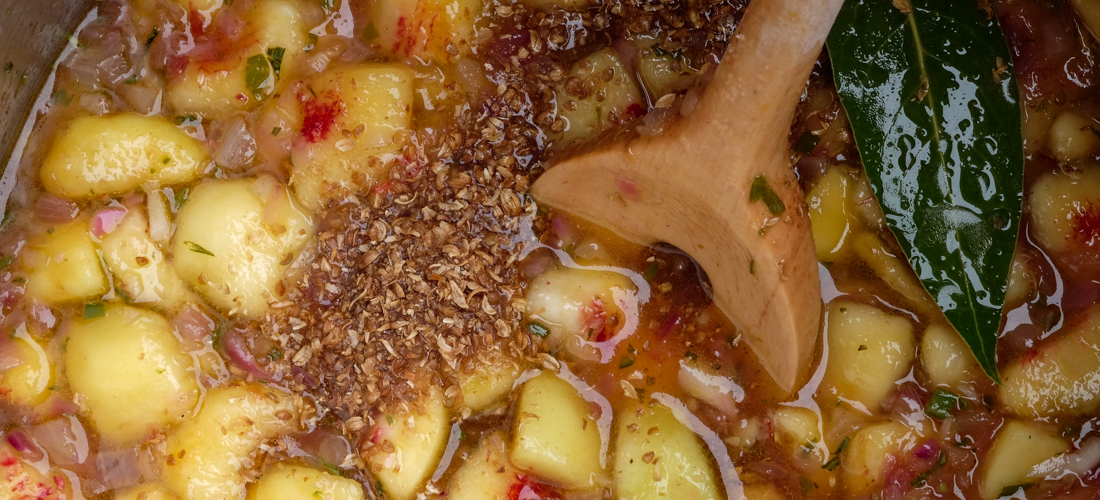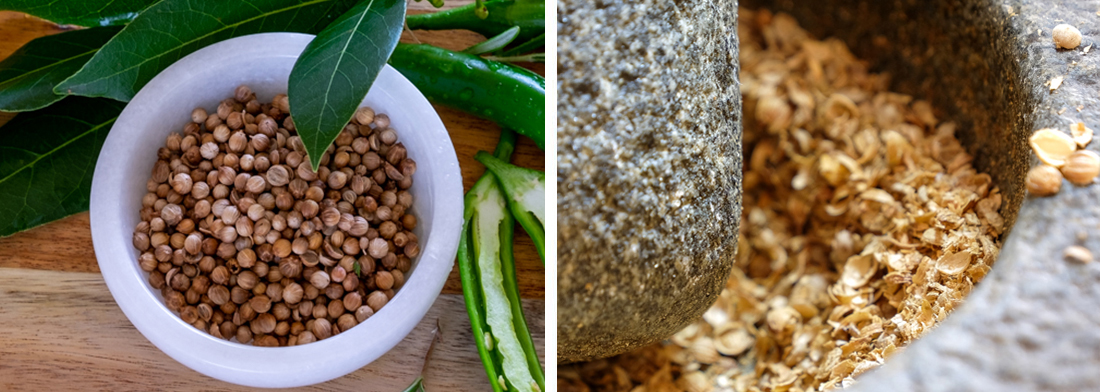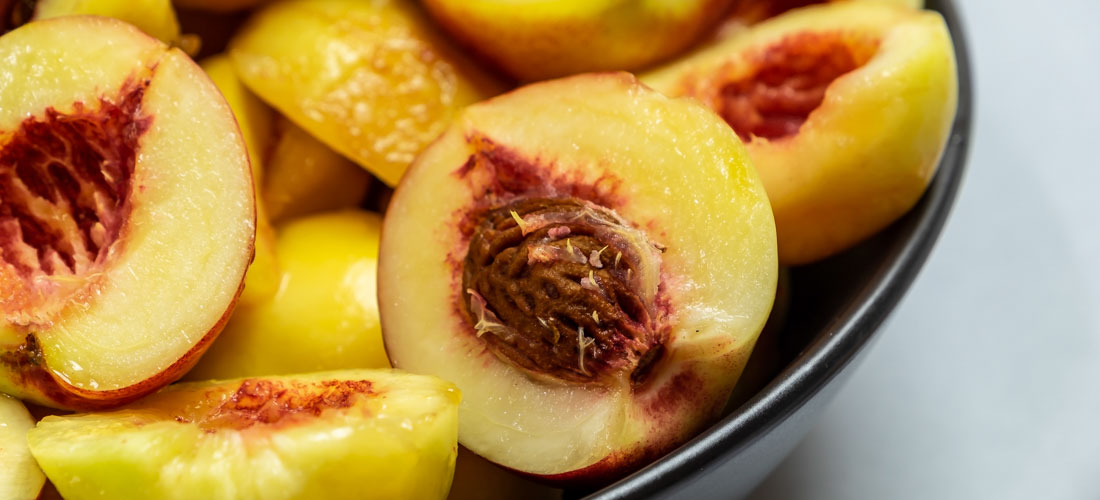Nectarine Relish
- Pickles, Chutney, Relish & Sauces

This fruity and vibrant nectarine relish is simple to make, yet it provides a vibrancy to whatever it accompanies. My favourites to serve it with are chicken, fish, and creamy white cheese. Make the most of when nectarines are in season- traditionally a summer stone fruit- and make enough to gift around the Christmas New Year period when there’s always a lot of home entertaining happening. It can be made with either white or yellow nectarines, both have similar acid levels, however white nectarines will taste sweeter when ripe as they contain less acid. So regardless of whether you use white or yellow, make sure they are ripe, so their delicate flavour is fully developed.
- Preparation Time:
- 30 minutes
- Cooking Time:
- 45 minutes
- Quantity:
- 4 x 300 ml jars
INGREDIENTS
- 2 tablespoons
- Olive Oil
- 250g
- Red onion, finely chopped
- 2
- Green chillies, fresh
- 2 teaspoons
- Rosemary, fresh
- 2
- Bay leaves
- 750g
- Nectarines, ripe
- 3 teaspoons
- Coriander seeds, crished
- 550g
- White sugar
- 330 ml
- Apple cider vinegar
- 1/2 teaspoon
- Salt
- 150g
- Raisins, optional

METHOD
Peel and finely chop the onion. Cut the chilies in half and finely chop. Remove the seeds for a milder chilli heat. Rinse, dry and finely chop the rosemary. Heat the oil in a preserving pan or large heavy bottom stainless steel pan.
Add the chopped onions, chilies, rosemary, and whole bay leaves. Cook gently, stirring frequently, until the onions are soft.
Gently wash nectarines to remove any garden or shop debris. Gently dry on paper or a tea towel to remove excess moisture and remove any bruised fruit. Peel the nectarines, cut nectarines in half and remove the stone. Cut into 2-3cm cubes. Discard the peel and stone.
Add the chopped nectarines, coriander seeds, sugar, salt and vinegar to the preserving pan. Bring to the boil slowly, stirring frequently to ensure the sugar is dissolved.
Simmer approximately 45 minutes until the onion is cooked and the relish is thick. If you are adding the raisins, add approximately 30 minutes into this final simmering stage. Stir occasionally during the cooking to prevent the relish from sticking to the pan. Taste and adjust flavourings as required.
Remove from heat and allow to cool for approximately 10 minutes.
Remove the bay leaves and stir gently to distribute the fruit. Using a funnel, pour into hot dry sterilised screw cap sealable jars.
Fill to approximately 2.5cm (1inch) from the top and seal with a hot dry sterilised lids.
Allow to cool and wipe down the jars, which may have become sticky, to remove any spilt relish during the bottling stage.
Label and store in a cool dark place in the kitchen or pantry.
Allow relish to mature for minimum of 4weeks before eating.
Once opened store in the refrigerator and use within 2 months.
NOTES
- Nectarines have a more delicate flavour than peaches, so to make an interesting preserve it needs to be teamed up with other ingredients that can provide a lift to the fruity nectarine base.
- Choose clean ripe fruit. Do not use overripe and never use mouldy fruit as this will produce a poor-quality chutney.
- If you want a chunkier fruit texture, cut fruit into larger pieces.
- Cooking times are an approximation only. They are provided as a guideline as cooking times are influenced by the type of pot and its diameter and height, speed of cooking and fruit ripeness, size, and moisture level. It is important to wash your hands thoroughly after handling and de-seeding chillies. Chilli oil is easily transferred to hands. If you touch your eyes or any delicate areas, the chilli oil will be transferred on contact and create a burning sensation.
- Why is chilli so hot?
- The legendary heat comes from a natural compound, capsaicin, which develops and is concentrated in the white pith with some migrating to the seeds. The amount of capsaicin a chilli contains depends upon the chilli variety and growing condition. High temperatures and drought can increase capsaicin production as the chilli ripens. To control and reduce the amount of heat, use the most appropriate variety and amount of chilli, remove as much or little of the white membrane and seeds and vary the length of contact time with other ingredients while cooking to suit your taste.
- Chilli heat or pungency is measured in Scoville Heat Units (SHU) which was developed in 1912. The higher the Scoville rating the hotter the chilli. The ubiquitous Jalapeno varies between 2,500 – 10,000 SHU which is mild compared to the Habanero and Scotch Bonnets 80,000 – 150,000 SHU or the hottest chilli in the world, the Carolina Reaper, which has been measured at 2million SHU! Aptly named the Reaper; use with extreme caution. SHU was developed in 1912. For more info on the dynamic chilli, my article Some Like it Hot, Hot, Hot: The Scoville Factor takes a closer look at the dynamic chilli.
- The type and colour of the sugar and vinegar used will affect the final colour and flavour of the chutney. Malt vinegar and brown sugar will produce very dark brownish red relish with a more earthy/molasses background flavour, while white wine vinegar or apple cider and white sugar will produce chutney that has a fresher and brighter flavour and colour. I enjoy clean fruity flavours of a relish and choose to use white sugar and apple cider vinegar.
- To test the chutney is cooked to the right consistency, spoon a little of the mixture on to a plate. The chutney should hold its shape.
- Towards the end of the cooking process, it may be necessary to stir occasionally to prevent the chutney from sticking on the bottom of the pan. But not too often so the fruit doesn’t break down into a mush.
- Always store chutney in a cool dark place. A warm area can cause it to ferment, and bright sunlight can affect the colour.
- Chutneys are best left to mature for 2 months in a cool dark place before eating. Traditionally they were stored in the cellar or pantry.
- What’s the difference between a relish and chutney? A relish is usually made with fruits that are cut into smaller pieces, more frequently made with white or cider vinegar, generally made with a lower proportion of vinegar and sugar and cooked for a shorter time. This results in a lighter flavour with a fresher, crisper consistency
- Variations: Nectarine and Peach Chutney. If you want to have a more predominate peach flavour, use a higher proportion of peach to nectarine fruit. The total weight and other ingredients remain the same.
- Coriander (Coriandrum sativum)
- A versatile spice, that has a bittersweet citrusy flavour with warm, floral undertones. Grown as an annual, stalks are cut before the fruits are fully ripe. They are threshed, cleaned, and dried. The stalks and roots are also edible and used frequently in Thai cooking.
- Powder is also available but loses its aroma quickly. It can act as a thickener.
- Native to the Mediterranean and Southern Europe, it's now cultivated throughout worldwide for its seeds and leaves.

